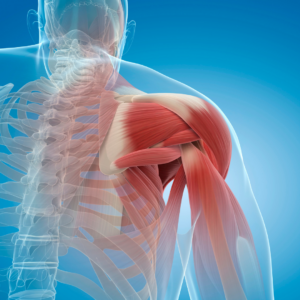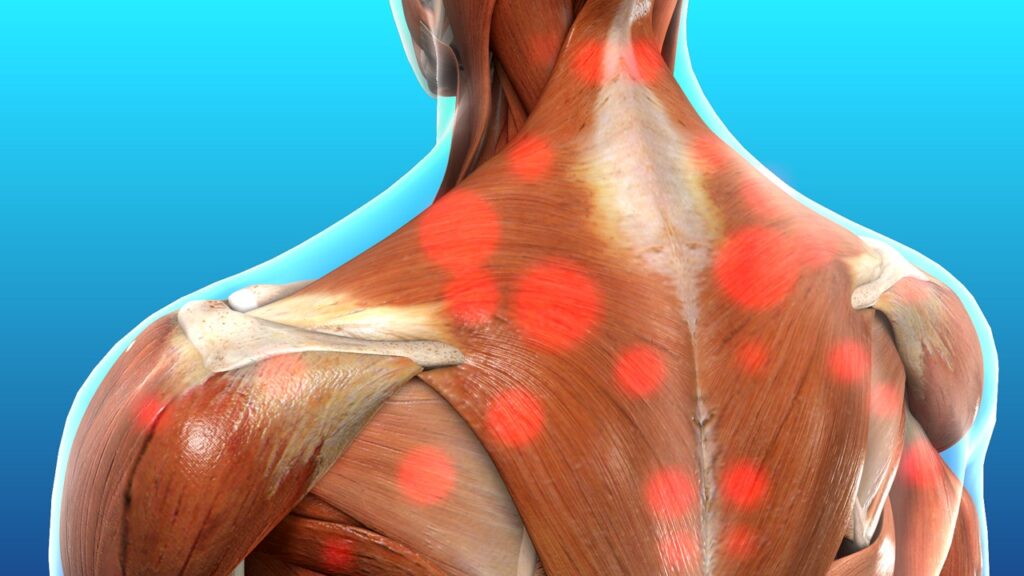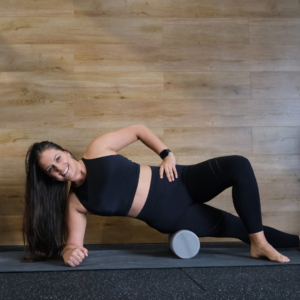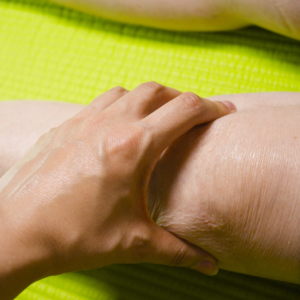What Is Myofascial Release and Does It Work?

So What Is Myofascial Release and Does It Work?
Let’s start with this question:
What is Myofascial Tissue?

It’s a complex network of tissue that permeates your entire body, connecting your muscles, joints, and bones. It plays a crucial role in providing support to your organs, ensuring they stay in their proper positions. If you could visualise it, the fascia would resemble a continuous sheet of tissue, but it actually consists of multiple layers that work together harmoniously.
Within these layers, there exists a fluid called hyaluronan, which has a vital role in maintaining flexibility and facilitating smooth movement. However, when this fluid becomes thick, sticky, or dehydrated, it can have a negative impact on the surrounding body parts and their functioning.
When you experience stiffness or pain in your body, it can stem from various tissues. Myofascial pain is unique because it arises at the points where your myofascial tissue intersects or overlaps. Identifying myofascial pain can be challenging since it tends to radiate from the affected area and spreads elsewhere.
Ordinarily, your myofascial tissue should feel pliable and elastic, allowing for optimal mobility. However, when it becomes tight or constricted, it can restrict movement in your muscles and joints. Compensating for this limited mobility, you may unintentionally adopt altered movement patterns, inadvertently exacerbating the tightness. Consequently, this can result in widespread pain and discomfort throughout your body.
Myofascial pain syndrome (MPS)

Myofascial pain syndrome (MPS) is a complex and chronic condition that you may be experiencing. It is characterised by the presence of trigger points in your muscles and fascia. These trigger points are hyperirritable areas within your muscle fibers that can cause localised pain and tenderness. The pain you feel in MPS is typically limited to specific regions or areas of your body rather than being widespread..
For example, you might be familiar with feeling pain and tenderness only in your right shoulder and neck. In this case, the trigger points responsible for the pain are likely located in the muscles and fascia of your shoulder and neck region. When you apply pressure to these trigger points, they may elicit referred pain, meaning that you might feel pain in a different part of your body, even though the actual trigger point is in your shoulder and neck. This referred pain can manifest as aching, burning, or sharp sensations.
While the exact mechanism behind the development of trigger points and the associated pain in MPS is not fully understood, it is believed that a combination of factors contributes to their formation. These factors include muscle overuse, trauma, poor posture, stress, and underlying medical conditions.
The symptoms of MPS can vary in intensity and frequency. Some individuals experience constant pain and tenderness, while others may have episodes of flare-ups. Activities that involve repetitive motions or prolonged muscle contraction, such as typing, lifting heavy objects, or maintaining an awkward posture, can worsen your pain.
It’s important to note that the pain you experience in MPS can sometimes be referred to seemingly unrelated parts of your body. For instance, trigger points in your shoulder and neck muscles might cause pain that radiates to your head, resulting in headaches, or to your upper back, causing discomfort in that area. This phenomenon of pain referral can make it challenging to accurately diagnose MPS, as the source of the pain may not directly correspond to the site of discomfort.
The primary symptoms of myofascial pain syndrome are:
- Localised muscle pain
- Trigger points that activate the pain
Infrequent but potential symptoms include:
- Muscle stiffness
- Fatigue
- Poor sleep
- Headaches
- Postural abnormalities such as hunching, shoulder rounding, or forward head posture (not aligned with spine)
How is Massage Different From Myofascial Release?

Regular massage involves stroking and kneading motions, usually administered with lubricants, making it easy for the therapist to slide their hands over the recipient’s skin. This is ideal for anyone with tension or tired muscles caused by exercise, sleeping in an odd position, and just ordinary daily stresses. Massages usually last 30-60 minutes and can relieve muscle tension including the release of “knots” in the muscles. While people usually feel peaceful afterwards (although sometimes sore from the release of the muscle knots), it doesn’t typically address pain in the connective tissue.
Myofascial release applies sustained pressure on targeted areas of connective tissue (fascia) that surround your muscles and bones. This pressure is meant to release the restriction in the connective tissue so that you have greater range of motion and less pain. The physical therapist, who is trained in myofascial release, maintains pressure for three to five minutes at a time in the targeted area. Using steady pressure is the key. The fibers must be allowed sufficient time to soften and stretch. No lubricant is added to the skin so the therapist can locate and release the areas of connective tissue that are restricted.
Myofascial Release Including Self Massage & How it Works

Myofascial release focuses on reducing pain by easing the tension and tightness in the trigger points. It’s not always easy to understand what trigger point is responsible for the pain. Localising pain to a specific trigger point is very difficult. For that reason, myofascial release is often used over a broad area of muscle and tissue rather than at single points.
Most myofascial release treatments take place during a massage therapy session. Some chiropractors and traditional medical practitioners may also offer it.
As a massage therapist, I begin each session by delicately massaging the myofascia, paying attention to any areas that feel stiff or tense. In their normal state, the myofascial tissues should be flexible and resilient. By applying gentle manual pressure, I work on these rigid areas, utilizing massage techniques and stretching to alleviate discomfort.
My goal as a therapist is to assist the tissues and their supportive sheaths in releasing any built-up pressure and tightness. This process is repeated multiple times on the same trigger point and other trigger points until I sense that the tension has been fully released.
It’s important to note that the areas I target for treatment may not necessarily be where the pain originates or where you perceive it most prominently. Myofascial release aims to address the broader network of muscles that could be contributing to your pain. By targeting trigger points across a wider section of your muscular system, myofascial release endeavours to reduce tension throughout your body.
Self-Massage Techniques You Can Do

If you notice tightness and can’t get an appointment right away for a massage, there are ways to relieve your symptoms from home. If you have problem areas, spend at least five minutes per day massaging the areas to stay ahead of stiffness.
Use your fingers to apply gentle pressure to your skin where you feel any discomfort. If you feel tenderness when you apply pressure, it’s a sign that you’ve identified the source of your stiffness.
Just as with a professional therapist, releasing the knots on your own may be painful or intense. Massage the area until you feel them release or loosen up to allow more movement. Then move on to find other tender areas.
You can invest in a foam roller or ball, but don’t assume that using these tools will solve your problems right away. It takes patience and dedication to listen to your body and work through the pain as you relieve tension in your myofascial tissue.
When you use these techniques shown in my short video daily, you can prevent stiffness and tightness from even happening. While you may still have episodes of pain, your overall symptoms should improve over time.
Who Might Benefit From Myofascial Release?

Patients with myofascial pain syndrome frequently benefit from this type of therapy. People who experience chronic headaches may also find relief from myofascial release. Gently massaging on tightened muscles in and around the neck and head may reduce headaches.
Some people with venous insufficiency, which occurs when blood pools in the deep veins of the leg, may also be candidates for myofascial release. During venous insufficiency, the blood pool stretches and eventually damages the veins in your legs. You may experience an aching and painful sensation in the affected leg. Myofascial release might be used in conjunction with other treatments to reduce the pooling and pain caused by venous insufficiency.
In conclusion, myofascial release is a technique that focuses on reducing pain and improving mobility by targeting trigger points and releasing tension in the myofascial tissue. Myofascial pain syndrome, characterized by the presence of trigger points and localized pain, can be effectively addressed through this therapy. By applying gentle manual pressure and utilizing massage techniques, myofascial release aims to alleviate discomfort and promote flexibility in the affected areas.
While myofascial release is commonly performed by massage therapists, self-massage techniques can also be employed to relieve symptoms at home. Spending dedicated time massaging problem areas and using tools like foam rollers or balls can help prevent stiffness and tightness. It is important to listen to your body, be patient, and work through any discomfort to effectively release tension in the myofascial tissue.
This therapy has shown promising results for individuals with myofascial pain syndrome and chronic headaches. Additionally, people with venous insufficiency, in combination with other treatments, may find relief from the pooling and pain in their legs through myofascial release.
While myofascial release can provide significant benefits, it is important to consult with a healthcare professional or a qualified therapist to determine the most appropriate course of treatment for your specific condition. By incorporating myofascial release into your wellness routine, you can improve overall symptoms and enhance your quality of life over time.
